Updated: 15-Sep-2020
There are two aspects: the first one is the Motor Building Plant in Samara.
-Formerly known as MV Frunze in Moscow, Plant number 24. Motor Building Production Assoc. (Related to A.A. Mikulin).
-In 1951 the TV-12/NK-12 engines were built. In 1963 it was renamed Aviation Plant, number 45 "Salyut".
-The second aspect is the one that has an old history of manufacturing engines (Motor) and that the facilities come from 1912, being one of the largest plant existing in Russia.
-Motorostroitel that is located in Samara has been dedicated to the manufacture of a wide range of aviation turbines, especially those of Nikolai Kuznetsov (see Kuznetsov), as well as rocket engines for space launchers such as the RD-107 and RD-108, designed by Energomash.
-Don't forget that in Russia, a product designed by an OKB could be manufactured in different plants at the same time.
-The RD-108 would be installed on the Soyuz 2 and began to be used for commercial launches from French Guiana Space Centre (see ZMDB Progress).
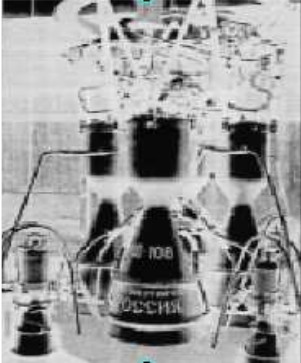
“RD-108” (PeT)
-Giving a review of Kuznetsov's engines, as we saw earlier, the TV-12 turboprop was his first job when he took over his design office, where he remained for 40 years, from 1949.
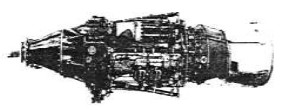
“NK-12”
-The TV-12 was made with the support of German engineers. It was renamed the NK-12, being the most powerful turboprop ever built with almost 15,000 CV.
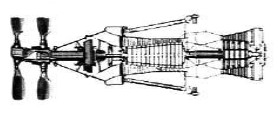
“NK-12, schematic drawing”
-The development of the NK-8 began in 1961, and was destined for the IL-62.

“NK-8-1”
-It was based on the ephemeral NK-6 project that was to be used for a supersonic bomber.
-In turn it would serve for the NK-144 of the Russian SST (the Konkordov) as well as the NK-22, NK-25, NK-86, NK-87, NK-88 and NK-89.
-Some of these engines we are going to see in this chapter.

“NK-8-51”
-The NK-22 is a derivative of the NK-144 for the Tu-22M bomber, with variable geometry.
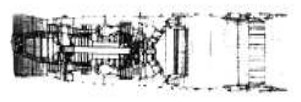
“NK-22”
-It has a three-stage fan and two shafts, the HP and the LP, it was to deliver 45,000 lbf of thrust, with afterburner.

“NK-22”
-It was also destined for the Tu-22. There was an improved version that became known as NK-23 but it did not prosper.
-The NK-25 began to be manufactured in 1976 and also with the purpose of improving the NK-22 for higher versions of the Tu-22, it gave 55,000 lbf with afterburner.
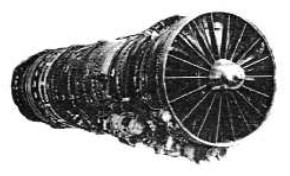
“NK-25”
-For the supersonic bomber "Blackjack" Tu-160 an improved version of the NK-32 was made, which was called NK-321. This engine delivered more than 55,000 lbf with afterburner.

“NK-32”
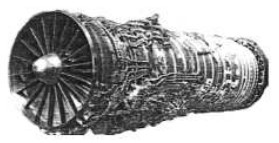
“NK-321”
-Taking advantage of the NK-321 "core", the NK-36 version was an engine intended for industrial uses. Around 1979, Kuznetsov decided to enter the high-ratio By-Pass turbofan system and developed two engines, the NK-56 with 40,000 lbf of thrust and the NK-64 that gave 35,000 lbf.
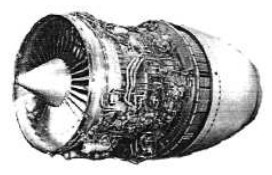
“NK-64”
-In turn, these would be the basis for two turboprops such as NK-62 and NK-110.
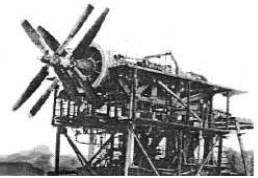
“NK-62 on a bench”
-The shaft power is not known, but it is clear that it is the most powerful turboprop in the world for now. It has been discontinued in favor of the NK-93 and NK-110.
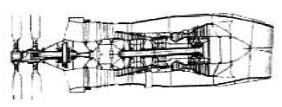
“NK-62, schematic drawing”
-From the NK-8 family there is the NK-86 bound for the IL-86. The engine was certified in 1979.
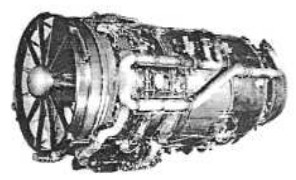
“NK-86”
-Both the NK-86 and the NK-87 have the same power, about 28,500 lbf of thrust.
-The NK-86A version gave something more, about 29,300 lbf.

“NK-87”
-For an interesting test of engines running on liquid nitrogen instead of the classic kerosene, an NK-8 was specially prepared to be installed on a totally modified Tupolev Tu-155.
-In fact, the entire passenger cabin was occupied by controls and cryogenic systems to maintain the nitrogen in liquid condition.
-The engine was named NK-88.
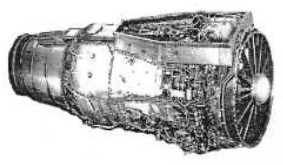
“NK-88”
-In the upper part we see a trapezoidal box that contains the controls for the nitrogen that previously has been converted into gas by an exchanger on the plane.

“NK-89”
-In 1989, with the NK-89, tests began with this aircraft running on liquid nitrogen.
-It had previously been replaced by the NK-88 carried by the Tu-155. Demonstration and exhibition flights were made.
-The NK-93 is an imposing turbofan with two faired front rotors of considerable size.
-The stipulated power is in the order of 45,000 lbf of thrust.
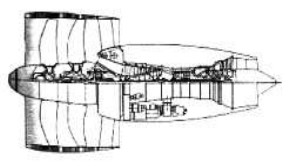
“NK-93”
-It was planned for high tonnage aircraft such as the IL-96-300 and the Tu-204.
-It is a pusher-type, double turboprop, that is to say with the propellers at the rear, which is the new concept of the NK-110 engine and that, as we have seen, inherits the experience of other Kuznetsov engines.
-This even more powerful engine will deliver more than 21,000 CV to the shaft.

“NK-110”
-In the photo of the NK-110 we see this engine from the front and without the propellers at the rear.
-And in the diagram below, we see the engine with the air inlet to the compressor on the left and the gas outlet through the duct formed between the propeller shaft and its outer shell, on the right.
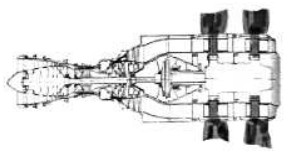
“NK-110. schematic drawing”
-Finally in 1998, a "small" turbojet is designed for a light front-line fighter. It delivers 6,000/9,000 lbf depending on the version. It is the NK-118 engine and the aircraft would be the Sukhoi Su-54.
Engines of MOTOROSTROITEL
Model: NK-110
Arquitecture:
Compressor/s:
Combustion chambers:
Turbines:
Power / Thrust: / ---
Weight:
Model: NK-118
Arquitecture:
Compressor/s:
Combustion chambers:
Turbines:
Power / Thrust: / ---
Weight:
Model: NK-12
Arquitecture:
Compressor/s:
Combustion chambers:
Turbines:
Power / Thrust: / ---
Weight:
Model: NK-22
Arquitecture:
Compressor/s:
Combustion chambers:
Turbines:
Power / Thrust: / ---
Weight:
Model: NK-23
Arquitecture:
Compressor/s:
Combustion chambers:
Turbines:
Power / Thrust: / ---
Weight:
Model: NK-25
Arquitecture:
Compressor/s:
Combustion chambers:
Turbines:
Power / Thrust: / ---
Weight:
Model: NK-32
Arquitecture:
Compressor/s:
Combustion chambers:
Turbines:
Power / Thrust: / ---
Weight:
Model: NK-321
Arquitecture:
Compressor/s:
Combustion chambers:
Turbines:
Power / Thrust: / ---
Weight:
Model: NK-36
Arquitecture:
Compressor/s:
Combustion chambers:
Turbines:
Power / Thrust: / ---
Weight:
Model: NK-62
Arquitecture:
Compressor/s:
Combustion chambers:
Turbines:
Power / Thrust: / ---
Weight:
Model: NK-64
Arquitecture:
Compressor/s:
Combustion chambers:
Turbines:
Power / Thrust: / ---
Weight:
Model: NK-8
Arquitecture:
Compressor/s:
Combustion chambers:
Turbines:
Power / Thrust: / ---
Weight:
Model: NK-86
Arquitecture:
Compressor/s:
Combustion chambers:
Turbines:
Power / Thrust: / ---
Weight:
Model: NK-87
Arquitecture:
Compressor/s:
Combustion chambers:
Turbines:
Power / Thrust: / ---
Weight:
Model: NK-88
Arquitecture:
Compressor/s:
Combustion chambers:
Turbines:
Power / Thrust: / ---
Weight:
Model: NK-89
Arquitecture:
Compressor/s:
Combustion chambers:
Turbines:
Power / Thrust: / ---
Weight:
Model: NK-93
Arquitecture:
Compressor/s:
Combustion chambers:
Turbines:
Power / Thrust: / ---
Weight:
Model: RD-0216 / RD-0217 / RD-0237
Arquitecture:
Chambers:
Fuels:
Feed System:
Ignition:
Thrust:
Weight:
Model: RD-107, -Á
Arquitecture:
Chambers:
Fuels:
Feed System:
Ignition:
Thrust:
Weight:
Model: RD-108, -A
Arquitecture:
Chambers:
Fuels:
Feed System:
Ignition:
Thrust:
Weight:
Model: RD-214 / RD-253 / RD-275
Arquitecture:
Chambers:
Fuels:
Feed System:
Ignition:
Thrust:
Weight:
Model: TV-12 (NK-12)
Arquitecture:
Compressor/s:
Combustion chambers:
Turbines:
Power / Thrust: / ---
Weight:


